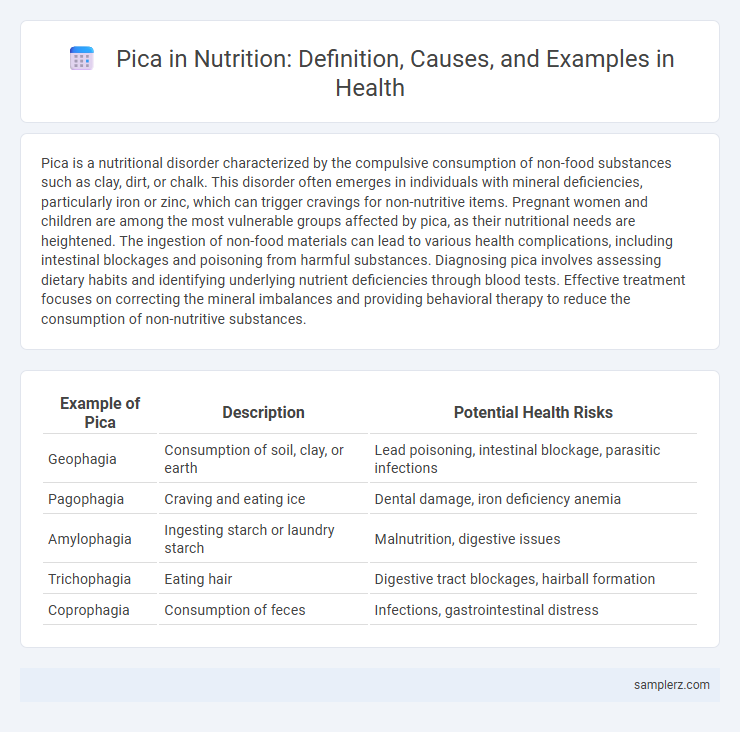Pica is a nutritional disorder characterized by the compulsive consumption of non-food substances such as clay, dirt, or chalk. This disorder often emerges in individuals with mineral deficiencies, particularly iron or zinc, which can trigger cravings for non-nutritive items. Pregnant women and children are among the most vulnerable groups affected by pica, as their nutritional needs are heightened. The ingestion of non-food materials can lead to various health complications, including intestinal blockages and poisoning from harmful substances. Diagnosing pica involves assessing dietary habits and identifying underlying nutrient deficiencies through blood tests. Effective treatment focuses on correcting the mineral imbalances and providing behavioral therapy to reduce the consumption of non-nutritive substances.
Table of Comparison
| Example of Pica | Description | Potential Health Risks |
|---|---|---|
| Geophagia | Consumption of soil, clay, or earth | Lead poisoning, intestinal blockage, parasitic infections |
| Pagophagia | Craving and eating ice | Dental damage, iron deficiency anemia |
| Amylophagia | Ingesting starch or laundry starch | Malnutrition, digestive issues |
| Trichophagia | Eating hair | Digestive tract blockages, hairball formation |
| Coprophagia | Consumption of feces | Infections, gastrointestinal distress |
Understanding Pica: An Overview in Nutrition
Pica is a nutritional disorder characterized by the persistent craving and consumption of non-food substances such as dirt, chalk, or ice. Common examples include geophagia (eating soil) and pagophagia (consuming ice), often linked to mineral deficiencies like iron or zinc. Recognizing pica symptoms is crucial for early diagnosis and targeted nutritional intervention to address underlying deficiencies and prevent complications.
Common Non-Food Substances Consumed in Pica
Common non-food substances consumed in pica include dirt, clay, chalk, ice, and paper. These items are often ingested due to mineral deficiencies such as iron or zinc, leading to craving and consumption of non-nutritive materials. Persistent consumption of these substances can cause gastrointestinal blockages, nutritional deficiencies, and dental injury, highlighting the need for early diagnosis and treatment.
Geophagia: Eating Soil and Its Nutritional Implications
Geophagia, a form of pica involving the consumption of soil, is practiced in various cultures, often driven by mineral deficiencies such as iron or calcium. Eating certain types of soil can interfere with nutrient absorption and may introduce harmful pathogens or toxins, posing health risks. Understanding geophagia's nutritional implications is crucial for addressing underlying deficiencies and preventing potential digestive complications.
Pagophagia: Ice Consumption and Mineral Deficiencies
Pagophagia, a specific form of pica, involves the compulsive consumption of ice and is often linked to iron-deficiency anemia and other mineral deficiencies. This behavior may serve as a coping mechanism to alleviate oral inflammation caused by these deficiencies. Clinical studies indicate that treating underlying iron or mineral shortages typically reduces or eliminates pagophagia symptoms.
Amylophagia: Starch Craving and Nutritional Risks
Amylophagia, a subtype of pica, involves the compulsive craving and consumption of starch-rich substances like laundry starch, cornstarch, or raw potatoes, which poses significant nutritional risks including iron-deficiency anemia and gastrointestinal blockages. This behavior often results in nutrient displacement, leading to deficiencies in essential vitamins and minerals critical for metabolic and immune functions. Managing amylophagia requires a multidisciplinary approach involving nutritional rehabilitation and psychological intervention to address underlying causes and prevent long-term health complications.
Consequences of Consuming Chalk and Clay
Consuming chalk and clay as examples of pica can lead to severe nutritional deficiencies and gastrointestinal complications. These substances may cause intestinal blockages, impair mineral absorption, and introduce harmful toxins, increasing the risk of anemia and other health disorders. Chronic ingestion often results in dental damage and essential electrolyte imbalances, further compromising overall health.
Health Impacts of Eating Paper and Cardboard
Consuming non-food items like paper and cardboard, a form of pica, can lead to digestive blockages, malnutrition, and exposure to harmful chemicals or toxins embedded in these materials. Persistent ingestion may cause abdominal pain, impaired nutrient absorption, and increased risk of gastrointestinal infections. Health professionals emphasize early detection and treatment to prevent severe complications and ensure proper nutritional intake.
Psychological Factors Contributing to Pica
Psychological factors contributing to pica include stress, anxiety, and developmental disorders such as autism or intellectual disability, which often manifest in cravings for non-nutritive substances like dirt, chalk, or paper. Emotional trauma and obsessive-compulsive disorder (OCD) are also linked to the onset of pica behaviors, disrupting normal nutritional intake and leading to potential health risks. Understanding these psychological underpinnings is critical for developing effective treatment approaches targeting both mental health and nutritional rehabilitation.
Diagnosing Pica: Signs and Symptoms in Nutrition
Pica is diagnosed by identifying persistent cravings and consumption of non-food substances such as dirt, chalk, or paper lasting for at least one month. Key signs include nutritional deficiencies like iron-deficiency anemia and gastrointestinal complications caused by ingesting indigestible materials. Healthcare providers often rely on patient history, physical examinations, and laboratory tests to confirm pica and its impact on overall nutrition.
Nutritional Management and Treatment for Pica
Pica is characterized by the persistent ingestion of non-food substances such as soil, chalk, or paper, often linked to nutritional deficiencies like iron or zinc. Nutritional management involves correcting these deficiencies through dietary supplementation and ensuring a balanced intake of essential vitamins and minerals. Behavioral interventions combined with regular monitoring and education on the risks of non-nutritive ingestion enhance treatment effectiveness and prevent recurrence.

example of pica in nutrition Infographic
 samplerz.com
samplerz.com